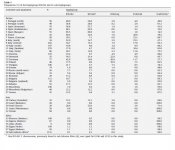In my opinion, u-152 is indeed a marker of the la tene culture brought to Italy via France and Switzerland. Many reliable historical sources, such as Livy , speak of many invasions of the italian peninsula from French Gauls. Livy for one, states that Bellovesus, king of the bituriges cubi, rounded up more than 300,000 men from various different tribes across France ( bituriges cubi hailed from central France) and brought them across the alps to Italy. He brought men from the arverni, ambarri, aedui, senones, lingones, carnutes, aulerci/cenomani and his own bituriges cubi tribe(s). (Check map of Gauls people on Wikipedia to see in what regions of France these tribes where originally centred at.) you can also see on many maps of ancient Italy and on Wikipedia maps of celts the senones both in France ( near Belgium) and the same tribe in the Marche region of Italy. The italian Cenomani can be traced to the cenomani of western France. The Emilia-romana lingones can be traced to north eastern France near Belgian and German border, etc. it is said that when these men arrived in northern Italy in the modern Lonbardy region, they encountered another group of men that called the self the Insubres. Upon realizing that Insubres was also the name of a canton/district in the homeland of his fellow Aedui tribesmen that ventured to Italy with him, he decided to keep that areas name as Insubria. He then proceeded to found mediolanum, modern day Milan, within the limits of Insubria, and he did so happily and peacefully while melting in his 300,000 men with these similar Celtic men. Livy also speaks of brennus's sack of Rome which took place a few hundred years earlier, so we already know that la teen Gauls where making their way far into the italian peninsula long before. Thus these attacking Gauls where waging war on men that, 1000 years earlier they would have called their own blood brothers. The Roman Empire was built by men that shared the same looks and genetic markers as these invaders, separated by a few hundred/thousand years. It is thus my strong conviction that the Latins where Gauls that arrived in Italy long before their cousin invaders and got separated/lost from them with time....and when they met up again, they no longer knew who they where due to relative isolation, nor had the knowledge of genetics to realize they where one and the same. Maybe 800 or a few thousand years before brennus's and his Gauls, a similar troop of men, cousins or genetic brothers to Gauls, left their la tene origin point near the Meuse/Loire/Moselle rivers in northeast France at an early point, crossed the alps, made their way over time to Rome, and set up a competing empire. This makes sense because the overwhelming majority of Italians are U-152. Why? Maybe because the Gaulish people's where very high concentration and only had u-152 when they came over in their small sample size. So the massive success and population growth that happened in Italy spawned from a few men, after generations, became MANY men all with u-152 subclade as was found in their bottleneckec small group of ancestors, all across north-central Italy, cisalpine Gaul, the so-called "Germanic" settlement areas, or more like Gaul/French settlement areas. The only inconsistency in my theory is that P312 ( the Iberian S-116) is found in high concentrations in Spain, Portugal, AND France, but at very low concentrations In Italy. If the Gauls did go from France to Italy, wouldn't italy also have traces of the Iberian/ west French S-116 lineage? Maybe not, if the s-116 migrated to France at a later time, after the departure of many U-152, a movement to fill in the "vacuum" hole of the massive U-152 departure. Needless to say, u-152 is still found in 15-20% of all areas of France and at a significantly higher frequency in Switzerland and north Italy.... Maybe this is why Cesar was always allied with lingones and aedui and Belgian remi against all the other Gaulish tribes, maybe in the end they where all the same thing!



